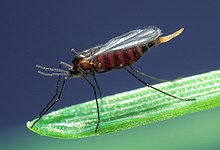Sciaroidea is a superfamily in the infraorder Bibionomorpha. There are about 16 families and more than 15,000 described species in Sciaroidea. Most of its constituent families are various gnats.
| Sciaroidea | |
|---|---|

| |
| The Hessian fly (Mayetiola destructor, Cecidomyiidae) | |
| Scientific classification | |
| Domain: | Eukaryota |
| Kingdom: | Animalia |
| Phylum: | Arthropoda |
| Class: | Insecta |
| Order: | Diptera |
| Infraorder: | Bibionomorpha |
| Superfamily: | Sciaroidea |
Description
editAs nematoceran flies, sciaroid adults generally have long segmented antennae, while their larvae have a well-developed head and mouthparts.[1]
Aside from this, sciaroids vary in appearance. For example, Sciaridae adults have each eye extended dorsally to form an "eye bridge", a feature not found in related families.[2] Cecidomyiidae adults have a distinctive reduced wing venation, while their larvae are atypical for nematoceran larvae in having a very small head capsule.[3]
Ecology
editMost fungus gnats (Sciaroidea excluding Cecidomyiidae) live in forests with their larvae occurring in fungi, dead wood and soil. There are some which live in wetlands such as fens.[4] Several genera of Sciaridae and Mycetophilidae may reach high abundances in damp buildings with wet organic matter.[5]
Some species of Sciaridae and Cecidomyiidae are among the rare Diptera that spend their entire lives in soil. These are wingless as adults.[6]
Sciaroid larvae typically feed on fungi but there are some which form plant galls (many Cecidomyiidae) or prey on other invertebrates (Keroplatidae).[7]
Phylogeny
editA 2016 molecular phylogenetic analysis confirmed that Sciaroidea is a monophyletic group and should include both Cecidomyiidae and Ditomyiidae.[8]
Families
editThese 15 families belong to the superfamily Sciaroidea:[9]
- Bolitophilidae Meigen, 1818
- Cecidomyiidae Newman, 1835 – gall midges and wood midges, sometimes excluded from Sciaroidea
- Diadocidiidae Winnertz, 1863
- Ditomyiidae Kylin, 1919
- Keroplatidae Rondani (incl. Lygistorrhinidae Edwards, 1925) – long-beaked & predatory fungus gnats
- Mycetophilidae Newman, 1834
- Rangomaramidae Jaschhof and Didham, 2002 – long-winged fungus gnats[10]
- Sciaridae Billberg, 1820 – dark-winged fungus gnats
- † Antefungivoridae Rohdendorf, 1938
- † Archizelmiridae Rohdendorf, 1962
- † Eoditomyiidae
- † Mesosciophilidae
- † Paraxymyiidae Rohdendorf, 1946
- † Pleciofungivoridae Rohdendorf, 1946
- † Protopleciidae
References
edit- ^ "Suborder Nematocera - Flies (Order: Diptera) - Amateur Entomologists' Society (AES)". www.amentsoc.org. Retrieved 2022-10-20.
- ^ "Diptera | What Bug Is That?". anic.csiro.au. Retrieved 2022-10-20.
- ^ "Diptera | What Bug Is That?". anic.csiro.au. Retrieved 2022-10-20.
- ^ Salmela, Jukka; Kolcsár, Levente-Péter (2017-06-03). "New and poorly known Palaearctic fungus gnats (Diptera, Sciaroidea)". Biodiversity Data Journal. 5 (5): e11760. doi:10.3897/BDJ.5.e11760. ISSN 1314-2828. PMC 5345105. PMID 28325987.
- ^ Gibb, Timothy (2015), "Pest Insects", Contemporary Insect Diagnostics, Elsevier, pp. 153–245, doi:10.1016/b978-0-12-404623-8.00005-3, ISBN 978-0-12-404623-8, retrieved 2022-10-20
- ^ Frouz, Jan (1999), "Use of soil dwelling Diptera (Insecta, Diptera) as bioindicators: a review of ecological requirements and response to disturbance", Invertebrate Biodiversity as Bioindicators of Sustainable Landscapes, Elsevier, pp. 167–186, doi:10.1016/b978-0-444-50019-9.50013-3, ISBN 978-0-444-50019-9, retrieved 2022-10-20
- ^ Matile, Lo& (1997). "15. Phylogeny and evolution of the larval diet in the Sciaroidea (Diptera, Bibionomorpha) since the Mesozoic". Mémoires du Muséum national d'histoire naturelle. 173. Éd. du Muséum: 273–303. Retrieved 2024-06-06.
- ^ Ševčík, Jan; Kaspřák, David; Mantič, Michal; Fitzgerald, Scott; Ševčíková, Tereza; Tóthová, Andrea; Jaschhof, Mathias (2016-10-18). "Molecular phylogeny of the megadiverse insect infraorder Bibionomorpha sensu lato (Diptera)". PeerJ. 4: e2563. doi:10.7717/peerj.2563. ISSN 2167-8359. PMC 5075709. PMID 27781163.
- ^ Greenwalt, D.; Kjærandsen, J. (2019). "Fungus Gnats Online". Retrieved 2019-06-06.
- ^ Jaschhof, M.; Didham, R. K. (2002). "Rangomaramidae fam. nov. from New Zealand and implications for the phylogeny of the Sciaroidea (Diptera: Bibionomorpha)". Studia Dipterologica Supplement. 11: 1–60.
External links
edit- Data related to Sciaroidea at Wikispecies
- Media related to Sciaroidea at Wikimedia Commons